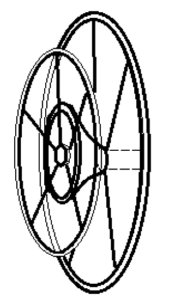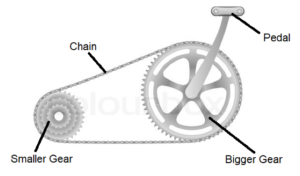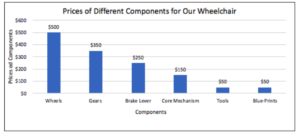The All-New Wheelchair
Purpose
The purpose of our project is to revolutionize the traditional wheelchair in order to make it more accessible and easier to maneuver.
Introduction
The easiest form of transportation is by walking. Without legs, people find it difficult to travel from one destination to the other. To address this problem, the wheelchair has been invented for those who are unable to walk. As helpful as the wheelchair may seem, it can still create problems such as having difficulty pushing the wheels and using weak material that may not last long.
Responding to this challenge, we propose a wheelchair in which the wheels and gears mimic that of a bicycle so that essentially, the wheelchair would be easier to push and maneuver. By pushing with less strength and increased speed, the user can travel from one place to another with little to no assistance. This is vital for children who are not yet strong enough to push themselves, those who have weak bones and muscles, and the elderly with insufficient strength. Like a bicycle, the wheelchair will have two gears: one for the user to turn, and the other to turn the rear wheel; however, unlike the bicycle where the two gears are placed next to each combined with a chain, the wheelchair’s “two gears” are in the forms of two circular bases of a truncated cone. A truncated cone is a cone with its tip removed to reveal a circular plane. Our new gear will be placed on both sides of the wheelchair with the larger circle of the gear connected to the push rim (the rim that the user pushes) and the smaller circle of the gear connected to the rear wheel. By having the user push the larger circle of the gear, the wheelchair’s smaller circle of the gear will turn faster, allowing the person to move further and faster without too much power. A more elaborate explanation and diagram will be provided below. We are also planning to create a lighter, cheaper, and more durable frame for the chair to have it cost less than the normal wheelchair while providing a long-lasting build. Combining the lower costs, stronger frame, and more accessible navigation, our wheelchair is without a doubt a revolution for the people who need it.
Possible Proposals
- Electric wheelchairs have been the ideal innovation in order to combat the difficulties in the traditional wheelchair. The electric wheelchair works in that there is a controller that allows individuals to signify where they would like to move. The controller resembles that of a videogame and the different movements signify the direction in which the chair is moving. This allows for access and little to no work, however, there is a hefty price that comes with the wheelchair. These wheelchairs range from $3,000-$30,000 (Karman Healthcare) depending on durability and comfort. Furthermore, the advanced technology within these chairs can confuse individuals who are used to traditional wheelchairs.
- Cons: Expensive and unfamiliarity.
- There is an innovation called the racing wheelchair which incorporates a similar mechanism that we do. However, this wheelchair is meant for sports activities and not a daily lifestyle. It is unsafe, compact, and not meant for comfort. Furthermore, it does not have a break. (Disabled Sports USA)
- Cons: Unsafe, compact, uncomfortable, and no breaks.
In contrast, our wheelchair is durable, inexpensive, comfortable, and safe. Furthermore, it adopts the wheelchair’s traditional style so individuals will not have a difficult time adjusting to our new innovation. In addition, for children may require three to four wheelchairs in their lifetime because the wheelchairs must fit according to their sizes. With the All-New Wheelchair, children will not have to worry about costs because our chairs are cost-efficient and cheap. The same can also be said for electric wheelchairs because they would have to spend on average $40,000 for new chairs accustomed to their sizes.
Structure
The wheelchair is composed of many parts: metallic frame, two push handles, two pushrims, brakes, armrests, backrest, footrest, two front casters, two rear wheels, and of course, the unique gear that connects the pushrim to the wheelchair’s wheel.

Figure 1. A labelled diagram of the fully constructed All-New Wheelchair showing the metallic frame, push handles, pushrims, brakes, armrests, backrest, footrest, front casters, rear wheels, and the gear (Model Systems Knowledge Translation Center.).
Parts of the Wheelchair:
- Metallic Frame
-
-
- The metallic frame is made of stainless titanium and steel. Titanium provides strength and durability. Stainless steel is cheap and prevents rusting. Steel is also easier to use for foldable mechanics as well (DiGiovine). The metallic frame will resemble the shape of a chair because it is for the user to sit in and navigate without the use of their legs.
-
- Two Push Handles
-
- The two push handles are attached to the top corners of the backrest. Their purpose is to allow another person to push the chair when the user is not pushing the wheels. Even though the user will not have a difficult time pushing, it is always convenient to include the handles on the chair for someone to push them.
- Two Pushrims
-
-
- The pushrims belong on both sides of the wheelchair for the user to push and turn the two rear wheels. They will connect the unique gear developed with the two rear wheels. The gear is used to push the wheelchair forward faster and easier.
-
- Brakes
-
-
- The brakes serve to halt the wheelchair in case of emergencies or as a way to decelerate the wheelchair if the user is moving too fast. A lever on the side of the wheelchair will serve to activate the break in order to maintain accessibility and ease when breaking.
-
- Armrests, Backrest, and Footrest
-
-
- These serve to provide user comfort. The armrest is for the individual to rest their arms when they are not using the wheelchair. It will be made of memory foam for more satisfaction. The backrest allows the user to lean back for resting. The footrest allows the person an area to place their feet on when they are seated in the wheelchair.
-
- Two front casters
-
-
- These two, small wheels exist to allow the user to make turns more easily when maneuvering. They can be swiveled at the slightest turn, providing the user no trouble navigating sharp corners and round bends.
-
- Two Rear Wheels
-
-
- These two large wheels are attached to the pushrim of the wheelchair. They serve to propel the wheelchair forward when the user pushes the pushrim. They are larger in size than the caster wheels because it will allow faster acceleration and an easier push.
-
- The Gear
-
- The gear is a cone-shaped component that connects the wheelchair’s pushrim with its rear wheel. There will be one on both sides of the wheelchair for the two rear wheels. Its function is to allow the user to push without immense effort. The gear will be fastened to the rear wheel and the pushrim with a nut and bolt through its hollow tube (see Figure 3). A detailed explanation of the gear’s mechanism that allows this to happen will be described on page 4.
Function
How the Gear Works
The shape of the gear is a truncated cone, meaning that it is a cone with the tip cut off to produce a flat, circular plane. It will have a hollow hole through it to be fastened together with the pushrim and the rear wheel via nut and bolt. A picture of the gear is shown below in Figure 4. The gear is shaped this way to rotate the rear wheels faster with a light push. It works by attaching the larger circle of the cone to the pushrim, and the smaller circle to the rear wheel. When this happens, the user will be able to accelerate further and faster. Focusing on the truncated cone, it is obvious to see that when it is rotated vertically (as shown in Figure 5), the smaller circle (attached to the rear wheel) rotates faster than the larger circle (attached to the pushrim). This means that when the user pushes the pushrim a small distance, the rear wheel will rotate a larger distance, resulting in a faster spin and acceleration. This allows the user to move forward faster and further with a smaller push.
To compare this to an everyday structure, our gear’s mechanism can be compared to the gears on a bicycle. When a biker pushes the pedal, the biker is rotating the larger gear of the bicycle which is connected to the pedals. This larger gear is then connected to a smaller gear by a chain to the rear wheel (see Figure 4). This means that applying pressure to the bike pedal enables the biker to rotate the rear wheel in greater magnitudes, allowing the biker to accelerate him or herself forward. By imitating this mechanism, our wheelchair’s gears also provide our users with the same function: greater acceleration for every push.

Figure 2. An illustration of the gear attached to the rear wheel and the push rim via nut and bolt.

Figure 3. An illustration of the disassembled rear wheel, push rim, nut, bolt, and gear.

Figure 4. A diagram of bicycle gears. The cyclist pushes down the pedal to move the bigger gear that is connected to the smaller gear via chain. Smaller turns on the bigger gear create bigger turns on the smaller gear. This is means less push equals more revolutions and more acceleration (Isabelle).

Figure 5. A simple illustration of the gear. It takes the shape of a truncated cone where the top reveals a circle with a smaller radius than the structure’s circular base. The axis of rotation represents how the gear will rotate when it spins.
The Process of Innovation:

In this bar graph, we view the cost of the innovation. This would be the total expenses of the adjusted wheelchair which came out to be $1,350 and with a 30% reduction, $945. The wheelchair parts compose of the wheels, handles, rear wheels, arm sets, gears, our innovative gear. The wheels are made of mild steel and titanium to provide sturdiness, as well as low cost. They average at $500 (Costhelper). The tools need to be of good quality so that the gears can be able to move functionally, and average for $50 (HomeDepot). As for the proper blueprints, it needs to be easier for us to sketch the diagrams of the wheelchair gears, parts, and even the location of the brake lever. We expect it to be $50 at most. The brake lever needs to be made of proper material that provides both durability and functionality. Some brake levers in the previous inventions either rust from the rain, or have weak handles that break easily. Thus, we want the lever to be made of stainless steel. Since there are no previous models of brake levers, we estimate its price to be $250. Stainless steel is a material that is known to be sturdy due to the fact that it contains less than 10% of iron and is thus, resistant to rust. The gears of the wheels are adjusted to have proper navigation, similar to a bicycle. The adjusted gears would be easier to turn by a hand to turn the wheel so navigation would not be a problem. We expect these to be made of stainless steel as well. The mild steel gears cost roughly $100 (IntelliWheels), and so we expect stainless steel ones to be approximately $350. Finally, the core mechanism, like the brake lever, is a new innovation so our estimated price for a stainless steel/titanium piece is $150. We can obtain funding for this project from organizations that are invested into better lifestyles for the elderly, disabled, and adolescents or funds in biomedical engineering that would like to see a cheap, but effective alternative to electric wheelchairs.
Group Roles
As for our roles, we plan to have equitable roles for each person in the making of this innovation. Rasha will find a material that is inexpensive and sturdy. She will also account for the sizing and comfort of the wheelchair. Benjamin will distinguish between the gears of the wheelchair in order to find an effective means that is not electric. Finally, Tamzid will create an effective brake lever that is easy to use. The gears and the brake are two very important key concepts to the wheelchair. Once we have the right parts, we will be able to completely revolutionize the wheelchair with a new, productive structure.
Scheduling:

The entire process of the proposal will take a month. During the first week, we will identify a research topic and formulate questions to start the research design of our innovation. On week 2, we will meet during club hours to start writing the research proposal, collect our data (for the costs), and write the first draft. On the weekend, we will meet through skype and use google docs to write the second draft and create the product of our innovation. At the end of the second weekend, we will also meet up and test the product at a park in order test the brakes and gears. After trial and error (week 3), we will finalize the product and make minor adjustments to see if the product works and functions properly. Finally, by the end of week 3, we would be at our last stage and manage to finish the final draft of our proposal.
References:
CostHelper. “How Much Does a Wheelchair Cost? .” CostHelper, CostHelper, health.costhelper.com/wheelchair.html.
DiGiovine, Carmen P. P. “Wheelchair.” Encyclopædia Britannica, Encyclopædia Britannica, Inc., 28 Apr. 2016, www.britannica.com/topic/wheelchair#ref314404.
Disabled Sports USA. “Wheelchair Racing.” Disabled Sports USA, Disabled Sports USA, www.disabledsportsusa.org/sport/wheelchair-racing/.
Home Depot. “Home Depot.” The Home Depot, Home Depot, www.homedepot.com/?irgwc=1&cm_mmc=afl-ir-1262330-456723-&clickid=WwCTRA3tDxyJWqJxTV1LXQupUklwIBSIE1OxzM0.
IntelliWheels. “IntelliWheels.” IntelliWheels, IntelliWheels, www.intelliwheels.net/#home.
Isabelle, Tiffany. “15 Bicycle Gear Vector Graphics Images.” 15 Bicycle Gear Vector Graphics Images – Bicycle Sprocket Vector Clip Art, Bike Gear Vector and Bike Gear Vector Clip Art / Newdesignfile.com, New Design File, 11 Dec. 2012, www.newdesignfile.com/post_bicycle-gear-vector-graphics_376953/.
Karman Healthcare. “Medicaid Electric Wheelchair – Medicare Wheelchairs.” Medicaid Electric Wheelchair, Karman Healthcare, www.karmanhealthcare.com/medicaid-electric-wheelchair/.
Model Systems Knowledge Translation Center. “The Manual Wheelchair: What the Spinal Cord Injury Consumer Needs to Know.” The Manual Wheelchair: What the Spinal Cord Injury Consumer Needs to Know | Model Systems Knowledge Translation Center (MSKTC), Model Systems Knowledge Translation Center, msktc.org/sci/factsheets/wheelchairs/The-Manual-Wheelchair.


